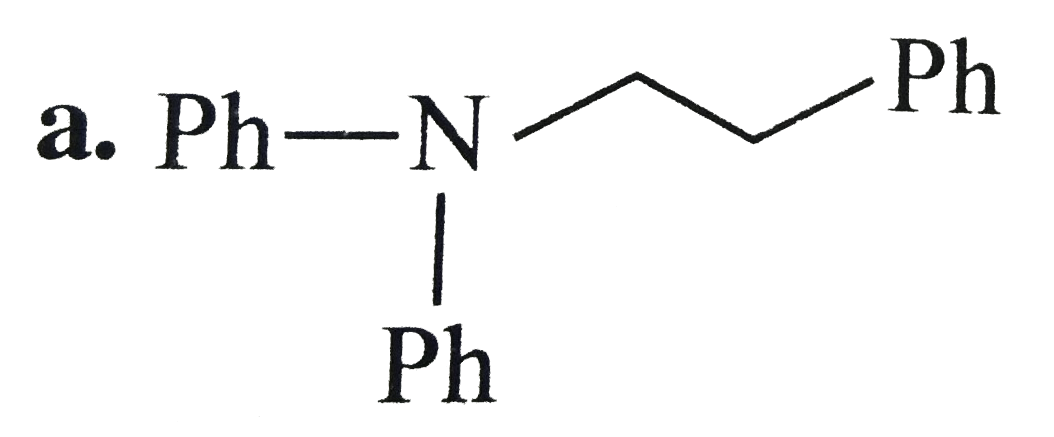Phenyl isocyanide + Benzyl magnesium bromide 1.EtherΔ−−−−−→2.H3O⊕(A). The compound (A) is :




The correct Answer is:D
To solve the problem involving the reaction of phenyl isocyanide with benzyl magnesium bromide, we will follow these steps:
Step 1: Identify the Reactants
We have two reactants:
- Phenyl isocyanide: This can be represented as Ph-N≡C, where Ph is the phenyl group (C6H5).
- Benzyl magnesium bromide: This is represented as Ph-CH2-MgBr.
Step 2: Understand the Reaction Conditions
The reaction occurs in the presence of ether and heat (denoted by Δ). Ether acts as a solvent, and heat facilitates the reaction.
Step 3: Mechanism of Reaction
1. Formation of Nucleophile: The benzyl magnesium bromide dissociates into Ph-CH2⁻ (the nucleophile) and MgBr⁺.
2. Nucleophilic Attack: The nucleophile (Ph-CH2⁻) attacks the carbon atom of the isocyanide (N≡C), leading to the formation of a new bond:
- The nitrogen in the isocyanide has a partial positive charge due to the triple bond with carbon, making it susceptible to nucleophilic attack.
- The reaction results in the formation of a compound where the nitrogen is bonded to the phenyl group and the carbon is bonded to the benzyl group.
Step 4: Formation of Intermediate
The product of the nucleophilic attack will be an intermediate compound that can be represented as:
- Ph-N=C(Ph-CH2)MgBr
Step 5: Hydrolysis
Upon hydrolysis (the second step in the reaction), the magnesium bromide (MgBr) leaves, and a hydrogen atom replaces it:
- The hydrolysis will yield the final product:
- Ph-NH-C(Ph-CH2)=O (which is an amine).
Step 6: Identify the Final Product
The final compound (A) can be identified as N-phenyl-1-phenylethylamine, which can be represented structurally as:
- N-phenyl-1-phenylethanamine
Conclusion
Thus, the compound (A) is N-phenyl-1-phenylethanamine.
Answer
The compound (A) is N-phenyl-1-phenylethanamine.
We have two reactants:
- Phenyl isocyanide: This can be represented as Ph-N≡C, where Ph is the phenyl group (C6H5).
- Benzyl magnesium bromide: This is represented as Ph-CH2-MgBr.
The reaction occurs in the presence of ether and heat (denoted by Δ). Ether acts as a solvent, and heat facilitates the reaction.
1. Formation of Nucleophile: The benzyl magnesium bromide dissociates into Ph-CH2⁻ (the nucleophile) and MgBr⁺.
2. Nucleophilic Attack: The nucleophile (Ph-CH2⁻) attacks the carbon atom of the isocyanide (N≡C), leading to the formation of a new bond:
- The nitrogen in the isocyanide has a partial positive charge due to the triple bond with carbon, making it susceptible to nucleophilic attack.
- The reaction results in the formation of a compound where the nitrogen is bonded to the phenyl group and the carbon is bonded to the benzyl group.
The product of the nucleophilic attack will be an intermediate compound that can be represented as:
- Ph-N=C(Ph-CH2)MgBr
Upon hydrolysis (the second step in the reaction), the magnesium bromide (MgBr) leaves, and a hydrogen atom replaces it:
- The hydrolysis will yield the final product:
- Ph-NH-C(Ph-CH2)=O (which is an amine).
The final compound (A) can be identified as N-phenyl-1-phenylethylamine, which can be represented structurally as:
- N-phenyl-1-phenylethanamine
Thus, the compound (A) is N-phenyl-1-phenylethanamine.
The compound (A) is N-phenyl-1-phenylethanamine.
Topper's Solved these Questions
- GRIGNARD REAGENTS AND ORGANOMETALLIC REAGENTSBOOK - CENGAGE CHEMISTRY ENGLISHCHAPTER - GRIGNARD REAGENTS AND ORGANOMETALLIC REAGENTSEXERCISE - Exercises Archives (Single Correct)
4 Videos
- GRIGNARD REAGENTS AND ORGANOMETALLIC REAGENTSBOOK - CENGAGE CHEMISTRY ENGLISHCHAPTER - GRIGNARD REAGENTS AND ORGANOMETALLIC REAGENTSEXERCISE - Exercises Archives (True/False)
1 Videos
- GRIGNARD REAGENTS AND ORGANOMETALLIC REAGENTSBOOK - CENGAGE CHEMISTRY ENGLISHCHAPTER - GRIGNARD REAGENTS AND ORGANOMETALLIC REAGENTSEXERCISE - Exercises (Multiple Correct)
16 Videos
- GENERAL PRINCIPLES AND PROCESS OF ISOLATION OF ELEMENTSBOOK - CENGAGE CHEMISTRY ENGLISHCHAPTER - GENERAL PRINCIPLES AND PROCESS OF ISOLATION OF ELEMENTSEXERCISE - Archives (Subjective)
14 Videos
- NCERT BASED EXERCISEBOOK - CENGAGE CHEMISTRY ENGLISHCHAPTER - NCERT BASED EXERCISEEXERCISE - Nuclear Chemistry (NCERT Exercise)
29 Videos
Similar Questions
(a)

(b)
( e) PhMgBrO2−−−→H3O⊕?
(f) Phenol+RMgI→?.
View Solution (i)CH3CHO−−−−−−−→(ii)H3O+ (A) HBr−−→ (B)
(i)CH3CHO−−−−−−−→(ii)H3O+ (A) HBr−−→ (B)
The compounds (A) and (B)
View Solution
∣HgSO4/H2SO4−−−−−−−−−−→(A)2molofMeMgBr/H3O⊕−−−−−−−−−−−−−−→(B). (B) is :
View SolutionC6H10NBS−−→(X)Mgether−−−−→(Y)CH3CN−−−−→H3O+(Z)
The compound (Z) is
View SolutionComplete the following reactions:
(A)Glyoxal1.NaOH−−−−−→2.H3O⊕(B)
View Solution (i)Mg/ether(ii)PhCHO−−−−−−−−−−−−−−−−→(iii)H3O+ Products
(i)Mg/ether(ii)PhCHO−−−−−−−−−−−−−−−−→(iii)H3O+ Products
View SolutionCH3−CH2−C≡CHR−−−→H3O⊕ Butanone, R is
View SolutionCH3CH2BrAgCN−−−→ANaOH,Δ−−−−−−−−→H⊕3OB, B is :
View SolutionFour isomeric optically active compounds NaHCO3−−−−−→CO2(g)(A,B,C,D)(C4H8O3)
Compound (A)LAH−−→(E) (Archiral compound)
Compound (B)KMnO4−−−−−→orCrO3 Inert to oxidation.
Compound (C)−−−−−−−−→NaOI/H3O⊕CHI3(Yellowppt.)+Compound(F).
Compound (C) is :
View SolutionFour isomeric optically active compounds NaHCO3−−−−−→CO2(g)(A,B,C,D)(C4H8O3)
Compound (A)LAH−−→(E) (Archiral compound)
Compound (B)KMnO4−−−−−→orCrO3 Inert to oxidation.
Compound (C)−−−−−−−−→NaOI/H3O⊕CHI3(Yellowppt.)+Compound(F).
Compound (D) is :
View Solution
